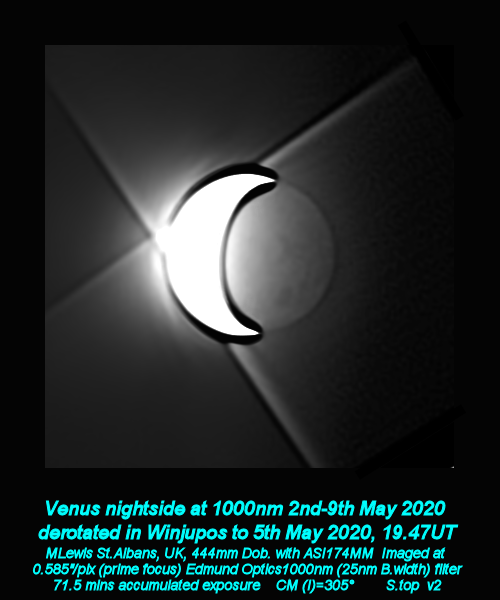Observation by Martin Lewis: Venus nightside at 1000nm 2nd/5th/6th/9t...
Uploaded by
Martin Lewis
Observer
Martin Lewis
Observed
2020 May 05 - 18:47
Uploaded
2020 May 11 - 18:42
Objects
Venus
Equipment
- 444mm Dobsonian
- Edmund Optics 1000nm IR (25nm bandwidth)
Exposure
71.5mins accumulated exposure
Location
St Albans, UK
Target name
Venus
Title
Venus nightside at 1000nm 2nd/5th/6th/9th May 2020
About this image
With Grischa Hahn just introducing the feature to be able derotate the night-side of Venus in Winjupos 11.1.4, at Anthony Wesley's request, I have combined my night-side images from 2nd, 5th, 6th and 9th May to create one super-derotation showing thermal features on the night-side derotated to a common date of the 5th May. This represents an accumulated exposure of 71.5 minutes at prime focus. Hoping to do a giff animation in the next few days showing the movement of these dark features over this span,
Cheers
Martin
Files associated with this observation
Like this image
Steve Knight,
David Strange,
Jeremy Shears,
Bill Leatherbarrow,
Chris Dole,
David Basey,
Ray Emery,
Mark Phillips,
Andy Wilson,
Peter Tickner,
Ron Johnson,
Paul G. Abel,
Andrew Dumbleton
Comments
Martin
I'm very glad to see this image. I've been debating with a colleague whether a ZWO ASI174 (the camera I also use for Venus) could see enough at 1000nm to capture anything. He was firmly of the view it couldn't and I'd be wasting my time trying to find a suitable 1000nm filter but now I know it is possible - although Im using a 356mm SCT so that may make it harder.
Peter
Hi Peter,
Yes surprisingly the ASI174MM turns out to be a good camera for imaging the night side despite the stated 2.5% quantum efficiency at 1000nm (I think in reality it is actually a bit higher than that). What really helps are the large pixels which gather 2.9x the light of say a Chameleon CS3 camera with its 3.45um pixels which Anthony Wesley and Phil Miles are using and which I also experimented with. I also experimented with an ASI290MM which is about 10% QE but pixels 4.1x smaller but that was blighted by secondary reflections.
The ideal camera for me working at f4.4 would have the ASI174MM's size pixels at 5.86um, the same IR response and read noise as an ASI290MM but no secondary reflections! Maybe by 2023 when the next good apparition occurs such a camera will exist!
Martin
Copyright of all images and other observations submitted to the BAA remains with the owner of the work.
Reproduction of work by third parties is expressly forbidden without the consent of the copyright
holder. By submitting images to this online gallery, you grant the BAA permission to reproduce them in
any
of our publications.


